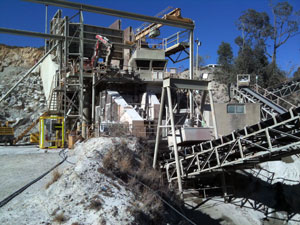Foam Dust Suppressant
How Does Foam Dust Suppression Work?
Dust is an inevitable by-product of the extraction and crushing process. Dependent upon the nature of the mineral, moisture content and particle sizes - the dust is released in to the environment during subsequent conveying, screening, stacking and loading operations.
In order to prevent dust particles from getting airborne foam is introduced at specific points in the crushing and/or conveying circuit. The object is to ensure foam is present at locations likely to produce (or release) dust. As the mineral / aggregate is crushed - new faces are exposed and dust particles are released. These dust particles collide with the foam dust suppressant bubbles piercing and thus releasing the moisture held therein.


The result is that the dust particle becomes thoroughly wetted and its increased weight causes it to be retained within the main body of the material. The wetted dust particles will then continue their entire journey through subsequent crushing, screening etc to the final storage bins without ever getting airborne.
To achieve effective foam dust suppression approximately 2 litres of solution converted to foam is required per one tonne of material. The solution is made up of up to 250 parts water to 1 part DUST-CHEM 76 - our foaming agent.
DUST-CHEM 76 foam dust suppressant is safe to use and biodegradable. It does not have any adverse effects in the cement making process, ready mix applications, concrete block making nor asphalt production.
Click here to contact us for more information about chemical dust control in WA, QLD, Victoria, Northern Territory, South Australia, New South Wales, Tasmania, New Zealand or Indonesia.








